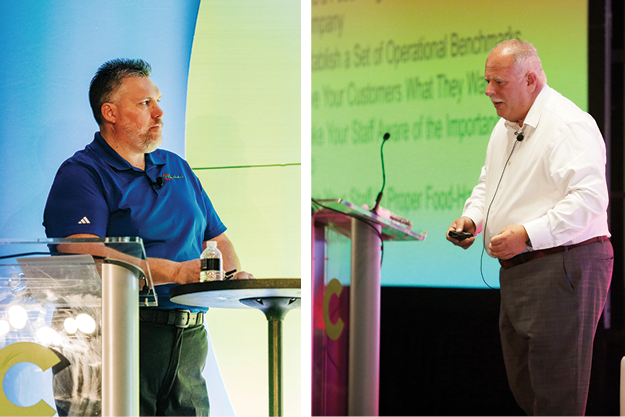About 10 years ago I heard a comment that I wholeheartedly disagreed with: Food safety isn’t measurable.
It was a curious statement, considering CDC data reports that 48 million people get sick, 128,000 are hospitalized and 3,000 die from foodborne diseases each year in the United States.
Perhaps this person wasn’t aware of how a company integrates its food safety plans and processes—the investments, training, resources and controls that are put into place. And on top of all that, how a company measures its risk in relation to its robust food protection programs.
Convenience stores are one of the fastest growing food retail channels. NACS State of the Industry data shows that foodservice sales—which encompass prepared food, commissary, and hot, cold and frozen dispensed beverages—at the top performing c-store companies average 35% of their inside sales; the overall industry average is 27%.
Dr. Jay Ellingson, chief science officer at Kwik Trip Inc., talked about the link between company growth and risk at the recent NACS Food Safety Forum, and cautioned against one outpacing the other—especially as c-stores continue to evolve their foodservice programs.
“If your company outgrows the pace of your food protection systems, you create areas where there are risks. We see examples in the news where the risk can become so great that the systems in place cannot protect consumers or an organization,” he said.
Convenience retail leaders must understand what’s at stake if a foodborne illness is linked to their brand, which may be why one Food Safety Forum attendee asked during a round of Q&A why more company leaders weren’t participating in the event.
 At the 2024 NACS Food Safety Forum, Dr. Jay Ellingson, chief science officer at Kwik Trip Inc., discussed the link between company growth and risk.
At the 2024 NACS Food Safety Forum, Dr. Jay Ellingson, chief science officer at Kwik Trip Inc., discussed the link between company growth and risk.
Top Food Safety Risk Factors
Each convenience retailer who presented at this year’s Food Safety Forum, as well as a related NACS Show Education Session, touched on how their companies are hyperfocused on safe food handling and delivering exceptional foodservice offers.
Although there are many food safety risks that cause foodborne illness, the following five are the most frequent culprits of a foodborne illness. They’re also the factors that result in the most health inspection violations:
- Poor personal hygiene (handwashing is still No. 1)
- Purchasing food from unsafe sources
- Failing to cook food adequately
- Using contaminated equipment
- Holding food at improper temperatures
“Focusing on these five will position your organization as best as possible for mitigating foodborne illness risk,” said Evan Powell, retail food protection manager at Kwik Trip Inc., during the NACS Show Education Session “Protecting Consumers and Your Brand With Food Safety Basics.”
These five risk factors also result in the most common health inspection violations. “A violation means that there is an opportunity for a foodborne illness to occur in your establishment,” said Wade Robinson, senior foodservice manager at Mirabito Convenience Stores.
Safe Sources
Sarah Friedrich of Kwik Trip Inc. and Beth Hoffer of Weigel’s Stores Inc. shared how their teams determine which food suppliers/vendors their respective companies will purchase from.
“Our Food Protection Administration team conducts food supply chain assessments, combining risk evaluations with on-site visits to our vendors’ production facilities. These assessments are guided by a scorecard that helps determine the risk level of each location before the visit takes place,” said Friedrich, a food protection analyst at La Crosse, Wisconsin-based Kwik Trip.
Kwik Trip teams visit and tour a vendor’s facility, which is also part of building a relationship that’s based on shared values and goals. “We’re looking to build that relationship before an incident happens. And if something were to happen, we know who to talk to,” Friedrich said.
Retailers should also ask for their distributors’ audits and certifications, information that will show whether the company is in compliance with the necessary food safety regulations.
Hoffer, the vice president of food and beverage at Knoxville, Tennessee-based Weigel’s, shared that her team also conducts audits on what it considers high-risk ingredients.
“For our raw chicken, we go to that plant every year and do an audit. We put our eyes on that,” she said, adding that for lower-risk items, “try to use someone who can help you with that, like your distributors.”
Thermometer Recalibration
ServSafe training cites the following method for recalibrating a thermometer:
1. Fill a large container with ice. Add clean tap water until the container is full and stir well.
2. Put the thermometer stem or probe into the ice water. Make sure the sensing area is under water and not touching the sides of the container. Wait 30 seconds or until the reading stays steady.
3. Adjust the analog thermometer so it reads 32°F (0°C). Hold the calibration nut securely with a wrench or other tool and rotate the head of the analog thermometer until it reads 32°F (0°C).
Cooking to Temp
Not properly maintaining safe temperatures for raw and cooked products is a huge food safety risk.
According to the Food and Drug Administration, using a food thermometer is the only way to ensure the safety of meat, poultry, seafood and egg products for all cooking methods to ensure these foods are cooked to a safe minimum internal temperature that destroys any harmful bacteria.
To make it easier for store teams to check food temps, “Have many thermometers available, and verify multiple temperatures from each batch produced,” suggested Powell, like taking the temperature of the thicker parts of a chicken tender, pieces from different corners of the fryer, and the thickest part of the meat on larger pieces.
Additionally, Friedrich said that when thermometers need to be recalibrated, the instructions should be clear and easy for employees to follow. For example, at Kwik Trip, store teams “don’t have to search for a piece of paper on how to calibrate the thermometers. … They have a picture with step-by-step instructions on the calibration mug itself and it works well for them,” she said.
Video training also works, said Powell, which is preferred by visual learners. Posters and documents work, but “If you can show them [what to do] with a training video that is accessible right in the store or kitchen, that would be even better,” he said.
 Left; Wade Robinson, senior foodservice manager at Mirabito Convenience Stores. Right: Chris Rapanick, managing director of NACS research, shared the most recent data on foodservice from the NACS CSX convenience benchmarking database and the NACS Convenience Voices survey.
Left; Wade Robinson, senior foodservice manager at Mirabito Convenience Stores. Right: Chris Rapanick, managing director of NACS research, shared the most recent data on foodservice from the NACS CSX convenience benchmarking database and the NACS Convenience Voices survey.
Holding Temps
Hot-holding foods must be kept above 135°F (57°C)—although a few states may stipulate 140°F if they’re still using an older food code. Cold-holding foods must be kept below 41°F (5°C).
David McIntyre, senior health and safety specialist at EG America, used a pot of chili to test Food Safety Forum participants’ acumen on how to properly cool down the product.
Most nailed the answer: According to the Food Safety and Inspection Service, foods like chili should be cooled from 135°F (57°C) to 70°F (21°C) within two hours to eliminate risk of pathogen growth, and then to 41°F (5°C) in the next four hours for a total of six hours.
Roller grill items like hot dogs have an unfair history of being publicly perceived as food safety hazards—as in stale hot dogs aimlessly rolling around for hours or days basking in harmful bacteria with every turn.
“Let’s break this one down a little bit. The word ‘cook’ is a misnomer. We’re not really cooking. Anything on that roller grill is fully cooked and commercially packed. What we’re doing is reheating it,” said McIntyre, noting that TCS foods like hot dogs—the acronym for time/temperature control for safety—should be kept at 135°F or higher to mitigate foodborne pathogen growth.
“Ultimately, you can’t have TCS food sitting at the temperature danger zone between 41°F and 135°F for an extended period of time—otherwise harmful bacteria will quickly multiply,” said Powell.
If a TCS food falls into that danger zone for four hours or more, harmful bacteria will double every 20 minutes.
Maintaining temperature logs to monitor hot and cold food holding is a tried-and-true method for mitigating this risk factor. Keep in mind that the Food Safety Modernization Act (FSMA) stipulates that all food safety records should be kept for at least six months, with accessibility within 24 hours.
“We have a continuous temperature monitoring system that alerts our operation support team when temperatures go above 41°F in our fresh case, our meat case and all of our coolers,” said Friedrich, adding that every four hours product is temperature logged.
Powell noted that in the unlikely event your stores are being investigated as part of a foodborne illness outbreak, you want to have documentation on hand that shows your food protection systems are in place. In other words: say what you do, do what you say and prove it.
Clean Hands, Please
The ServSafe exam tests for proper handwashing techniques. Here are the steps:
1. Wet your hands and arms with running water.
2. Apply soap.
3. Vigorously scrub hands and arms for at least 10 to 15 seconds.
4. Rinse your hands and arms thoroughly under running water.
5. Dry hands and arms with a single-use paper towel or hand dryer.
Sounds easy enough, yet improper handwashing—or a lack of handwashing—carries a huge risk for the spread of many diseases and conditions that can cause a foodborne illness, as well as some respiratory infections like adenovirus and hand-foot-mouth disease, according to the CDC.
Cross Contamination
This is the risk factor where harmful pathogens and allergens cross paths, but the two are different—like interchanging cleaning and sanitizing.
Cross contamination, explained Robinson, is when disease-causing microorganisms found in one food item are transferred to another food item, like using the same cutting board for preparing raw chicken and lettuce during food prep.
“This is dangerous,” Robinson cautioned. Although the disease-causing microorganisms found in raw chicken will be killed when the product is cooked to 165°F, that harmful bacteria has been transferred to the lettuce—which is not being cooked—and creates a foodborne illness risk.
Cross contact is more in line with allergens, said Robinson. The “big nine” allergens, according to the FDA (as of 2022), are milk, eggs, fish, shellfish, tree nuts, peanuts, wheat, soybean and sesame.
For example, cross contact can occur when peanut cookies and sugar cookies are prepared on the same surface. “We’ve now created a cross contact situation where a person with a peanut allergy eats a sugar cookie and has an allergic reaction to the peanuts,” Robinson explained.
Building Relationships
Both Ellingson and Powell shared another way that Kwik Trip manages its risk, and that’s through its relationships with state and local health officials and regulators.
During the Food Safety Forum, Melanie Harris, food safety manager, retail, at Casey’s General Stores, and Corrin Howard, senior regulatory compliance supervisor at Wawa, shared their experiences as former regulators, giving a unique perspective on the value of relationships with local regulators.
Harris, who was a health department inspector with the Iowa Department of Inspections, Appeals and Licensing prior to joining Casey’s, shared that convenience retailers need to be the ones who open the door to their regulators and establish a relationship. “I cannot stress enough how you want to do that prior to the emergency, which is not the time to introduce yourself,” said Harris.
 Wade Robinson, senior foodservice manager at Mirabito Convenience Stores.
Wade Robinson, senior foodservice manager at Mirabito Convenience Stores.
“Give them an opportunity to know you ahead of time, showcase what you’re doing and set up your brand and your program and allow them to comment on it. They are a resource for you to use,” Harris added.
Howard agreed that when a problem arises, that is not the time to get to know your health inspectors. She was a health inspector for 15 years prior to joining Wawa. “In my experience, regulators are very interested in getting to know the industry,” she said.
In terms of how the c-store industry can help drive the relationship between their companies and regulators, both Harris and Howard stressed that retailers need to be the ones behind the wheel.
“They’re not coming to you other than to inspect [your stores],” said Harris.
Both also find value in joining local food safety groups and task forces offered through health departments, attending regional health department meetings and joining national associations like NACS and others that have local affiliates, like the Association of Food and Drug Officials (AFDO) and the National Environmental Health Association (NEHA).
See You at the 2025 Food Safety Forum
These conversations will continue on April 8, 2025, in Dallas, Texas, at the NACS Food Safety Forum. The event will be co-located at the NACS State of the Industry Summit, which is a shift from being co-located at the NACS Show.
Top of mind will be the FSMA Traceability Rule and how the industry is preparing for 2026 implementation.
Registration is open now.
Preventative Actions
Powell outlined five “SMART” ways to organize a corrective action plan prior to a health inspection.
1. Specific: Is the corrective action plan detailed and understandable?
2. Measurable: Can it be easily evaluated?
3. Action based: Does it include a desired end result?
4. Realistic: Is the expected outcome reasonable?
5. Timely: Is the deadline attainable?
“If you don’t put a corrective action plan together, you could have repeat violations, especially the top five critical ones,” he said, noting that Kwik Trip uses a digital system to collect and store this information so that co-workers have immediate access.
“Get buy-in from the store employees and store management teams,” said Robinson, so they understand not just what that the company is trying to accomplish with food safety, but the why.
“There’s no secrets regarding food safety and it’s not a competitive advantage,” said Powell. “We don’t withhold anything—we want everyone to be successful with food safety.”
He also shared that if you “can control those top five risk factors, you will mitigate close to 95% of your foodborne illness risk.”
And that, my friends, is measurable.